Maintaining a flower bed requires regular care and attention to keep your garden looking its best. To ensure a vibrant and flourishing garden all season long, it is crucial to master the art of flower bed maintenance. By following these essential steps and techniques, you can create a stunning flower bed that will bring joy and beauty to your outdoor space.
- Remove spent flowers to prevent seed formation and maintain the overall health of the plants.
- Inspect your flower bed regularly for pests and problems, seeking professional advice if needed.
- Ensure proper watering techniques to keep the soil moist and nourish your plants.
- Pull weeds regularly to prevent them from competing with your flowers for nutrients and space.
- Maintain well-defined edges for a tidy and aesthetically pleasing flower bed.
Additional important steps include fertilizing and mulching your flower bed to provide essential nutrients and protect the soil, performing seasonal clean-up to protect your plants from harsh weather conditions, and carefully considering sunlight exposure, garden size, and soil preparation when designing and maintaining your flower bed.
By integrating both perennial and annual flowers, you can create a dynamic and vibrant display of colors that will continuously bloom throughout the seasons. With proper maintenance and attention to detail, your flower bed will flourish and become the centerpiece of your garden.
Why Flower Bed Maintenance is Important
Proper flower bed maintenance is crucial for creating a visually appealing and healthy garden space. Whether you have a small bed of flowers or an expansive garden, regular care is essential to ensure your plants thrive and flourish. By dedicating time and effort to maintain your flower bed, you can enjoy a vibrant and beautiful garden all season long.
Mastering flower bed maintenance is essential for creating a blossoming garden. Perennial gardens require regular care to stay healthy and beautiful.
One of the key aspects of flower bed maintenance is removing spent flowers. By snipping off flower stems just above a leaf or bud, you prevent the formation of seeds and promote continuous blooming. Additionally, it is important to inspect your flower bed for pests and problems. Look for signs of damage such as chewed flowers or buds, discolored or spotted leaves, or damaged stems. Seek advice from experienced staff at a garden center or cooperative extension service for identification and advice.
Proper watering techniques are also crucial for the health of your flower bed. Ensuring the soil is moist to a depth of 6-8 inches is essential. Consider using soaker hoses or drip irrigation pipes, as they are more efficient than overhead sprinklers.
Another important aspect of flower bed maintenance is weed control. Regularly pulling weeds helps keep your flower bed healthy by minimizing competition for nutrients and water. You can remove weeds by slicing them under the soil surface with a hoe or pulling them by hand.
Fertilizing and mulching are also key components of flower bed maintenance. Apply a granular, slow-release fertilizer formulated for perennial gardens in early spring to provide essential nutrients. Renew organic mulch, such as shredded bark or leaves, to help retain moisture and suppress weed growth.
By following these steps and considering sunlight exposure, garden size, and soil preparation, you can create a stunning flower bed that will thrive and blossom year after year. Combine both perennial and annual flowers for a garden full of vibrant color and continuous blooms. Remember to design your flower bed with careful consideration of plant spacing and heights. With proper maintenance, your garden will flourish and bring joy throughout the seasons.
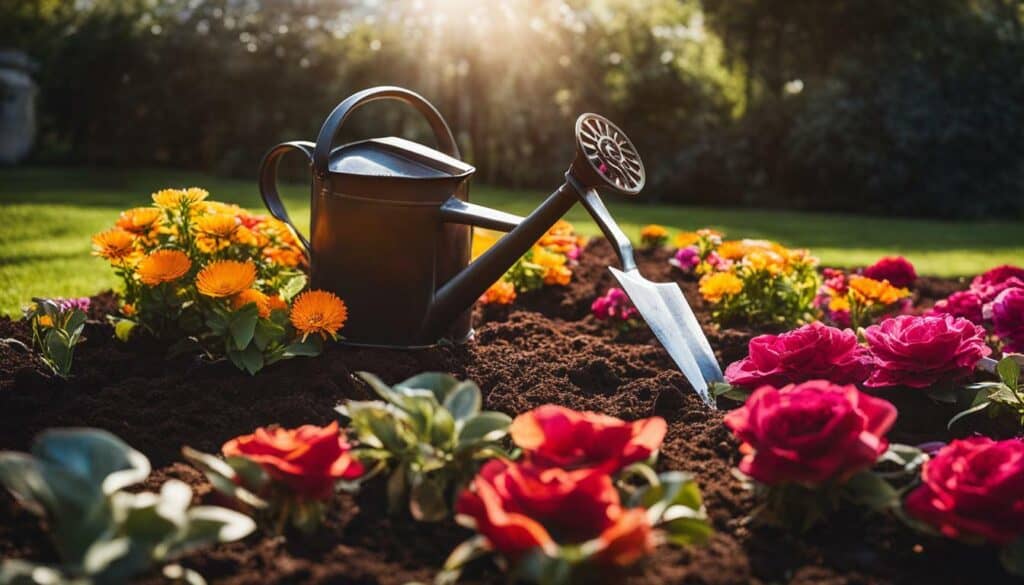
| Flower Bed Maintenance Tips: |
|---|
| 1. Remove spent flowers by snipping off stems just above a leaf or bud. |
| 2. Inspect your flower bed for pests and problems and seek advice if needed. |
| 3. Ensure proper watering techniques, keeping the soil moist to a depth of 6-8 inches. |
| 4. Control weeds by regularly pulling them or using a hoe. |
| 5. Fertilize and mulch your flower bed to provide essential nutrients and retain moisture. |
Removing Spent Flowers
Regularly removing spent flowers is vital for maintaining the vitality of your flower bed and encouraging new blooms. Snipping off flower stems just above a leaf or bud prevents the formation of seeds and redirects the plant’s energy into producing more flowers. Additionally, picking off damaged leaves helps to maintain the overall health and appearance of the flower bed.
When removing spent flowers, it’s important to use clean and sharp pruners or scissors to avoid damaging the plant. Be sure to snip the stem just above a healthy leaf or bud to stimulate new growth and prevent disease. Removing spent flowers also keeps the garden looking neat and tidy.
By regularly removing spent flowers, you not only promote the health and growth of your plants, but you also extend the blooming period. This is especially important for perennial flowers, as they can continue to bloom year after year with proper maintenance. It’s a simple yet effective task that can make a big difference in the overall appearance and performance of your flower bed.
Tips for Removing Spent Flowers:
- Inspect your flower bed regularly and remove spent flowers as soon as you notice them.
- Snip the stem just above a healthy leaf or bud.
- Pick off damaged leaves to promote overall plant health.
- Dispose of the spent flowers and leaves properly to avoid the spread of disease.
Remember, removing spent flowers is an ongoing task throughout the growing season. By incorporating this simple maintenance step into your gardening routine, you can enjoy a vibrant and blooming flower bed all season long.
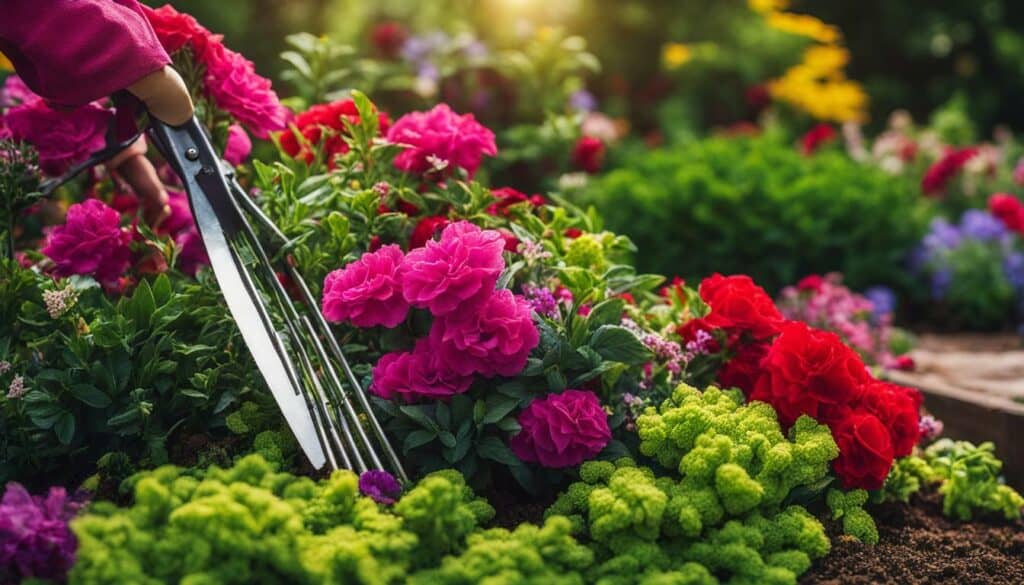
| Benefits of Removing Spent Flowers: | Tips for Removing Spent Flowers: |
|---|---|
| Stimulates new growth and encourages more flowers | Inspect your flower bed regularly |
| Prevents the formation of seeds | Snip the stem just above a healthy leaf or bud |
| Promotes overall plant health | Pick off damaged leaves |
| Keeps the flower bed looking neat and tidy | Dispose of spent flowers and leaves properly |
Identifying Pests and Problems
Vigilance in identifying pests and problems is crucial for maintaining the health and longevity of your flower bed. By regularly inspecting your plants, you can catch issues early on and take appropriate action to prevent further damage. Here are some common pests and problems to watch out for:
| Pests | Problems |
|---|---|
| Aphids | Yellowing leaves, distorted growth |
| Slugs and snails | Holes in leaves, slimy trails |
| Spider mites | Webbing, yellow stippling on leaves |
If you notice any of these pests or problems in your flower bed, it’s important to take action promptly. There are several methods you can use to control pests, such as using organic insecticides, introducing beneficial insects, or manually removing them. For certain problems, like nutrient deficiencies or diseases, adjusting the soil pH or applying appropriate fungicides may be necessary.
Prevention is Key
While dealing with pests and problems is inevitable, prevention is always better than cure. Here are some preventive measures you can take to minimize the risk:
- Choose disease-resistant and pest-resistant plant varieties.
- Maintain proper plant spacing to maximize air circulation.
- Keep the garden clean by removing fallen leaves and debris.
- Practice crop rotation to reduce the build-up of pests and diseases.
Remember to regularly monitor your flower bed for any signs of trouble and take appropriate action to protect your plants. By being proactive in pest and problem identification, you can maintain a healthy and thriving flower bed.

“Common Flower Bed Pests and Problems and How to Control Them.” University of Maryland Extension, https://extension.umd.edu/hgic/topics/common-flower-bed-pests-and-problems-and-how-control-them.
Proper Watering Techniques
Watering your flower bed correctly is essential for its overall health and vitality. Adequate moisture is crucial for the proper growth and development of plants, ensuring they receive the necessary nutrients to thrive.
Here are some tips to help you water your flower bed effectively:
- Water deeply: Instead of frequent shallow watering, which promotes shallow root growth, water your flower bed deeply. This encourages the roots to grow deeper into the soil, making the plants more resilient and better able to withstand drought conditions. Aim to moisten the soil to a depth of 6-8 inches.
- Use the right watering technique: Avoid overhead sprinklers, as they can waste water through evaporation and can cause fungal diseases. Instead, use soaker hoses or drip irrigation pipes to deliver water directly to the base of the plants. This ensures that the water reaches the roots where it is needed most.
- Water in the morning: Watering your flower bed in the early morning allows the moisture to penetrate the soil before the heat of the day. This prevents excessive evaporation and fungal growth, as the foliage has time to dry out during the day.
- Monitor the moisture level: Use a moisture meter or simply check the soil by sticking your finger into it. If the top inch of soil feels dry, it’s time to water. Be careful not to overwater, as this can lead to root rot and other problems.
By following these watering techniques, you can ensure that your flower bed receives the right amount of moisture, promoting healthy growth and vibrant blooms.
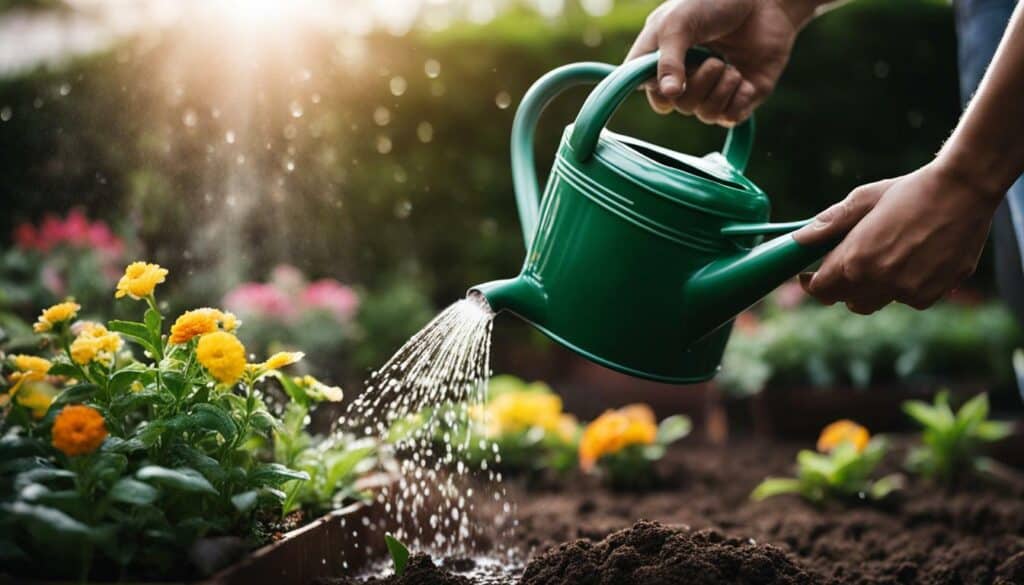
“When watering, remember to focus on the root zone rather than the foliage. Directing water at the base of the plants ensures that it reaches the roots where it is most needed for optimal growth.”
Remember, different plants have different watering needs, so it’s important to consider the specific requirements of the flowers in your bed. Factors such as the plant’s water retention capabilities, the type of soil, and the weather conditions should all be taken into account when determining your watering schedule.
Summary:
Proper watering techniques are crucial for maintaining a healthy and thriving flower bed. Water deeply, use the right watering technique, water in the morning, and monitor the moisture level to ensure your plants receive the right amount of water. By following these tips, you can promote healthy growth and vibrant blooms in your garden.
Weed Control
Regular weed control is necessary to maintain the beauty and health of your flower bed. Weeds compete with your flowers for essential nutrients, water, and sunlight, hindering their growth and overall vitality. To keep your flower bed weed-free and flourishing, follow these effective weed control methods:
- Manual weed removal: Pull weeds by hand, making sure to remove the entire root system. This method is ideal for smaller, manageable infestations.
- Mulching: Apply a layer of organic mulch, such as shredded bark or leaves, around your flowers. Mulch helps suppress weed growth by blocking sunlight and preventing weed seeds from germinating.
- Chemical weed control: Use selective herbicides that target only the weeds, not your flowers. Follow the instructions carefully, applying the herbicide directly to the leaves of the weeds. Be cautious and avoid contact with desirable plants.
Regularly inspect your flower bed for any signs of weed growth and take immediate action to prevent their spread. By staying proactive and implementing these weed control methods, you can maintain a weed-free flower bed and ensure the optimal growth and beauty of your plants.

Remember, prevention is key when it comes to weed control. Taking steps to minimize weed growth, such as applying mulch and pulling weeds as soon as they appear, will save you time and effort in the long run. Additionally, maintaining well-defined edges around your flower bed can help prevent weeds from encroaching from the surrounding areas.
Quick Tip:
“Regularly inspect your flower bed for any signs of weed growth and take immediate action to prevent their spread.”
With proper weed control techniques, you can ensure that your flower bed remains a vibrant, weed-free sanctuary for your plants to thrive. By dedicating time to weed management as part of your garden care routine, you’ll create an environment conducive to the growth and beauty of your flowers.
| Weed Control Methods | Advantages |
|---|---|
| Manual weed removal | – Targets specific weeds – Effective for small infestations – Environmentally friendly |
| Mulching | – Suppresses weed growth – Conserves soil moisture – Enhances soil fertility |
| Chemical weed control | – Targets specific weeds – Provides quick and widespread control – Easy application |
By incorporating these weed control methods into your flower bed maintenance routine, you can create a beautiful and healthy garden that blossoms with vibrant flowers all season long.
Maintaining Well-Defined Edges
Keeping the edges of your flower bed well-defined adds a touch of elegance and enhances the overall appearance of your garden. It creates a clean and tidy look, separating your flower bed from the surrounding lawn or walkway. Plus, maintaining well-defined edges prevents grass and weeds from encroaching onto your flower bed, reducing the need for constant weeding and edging.
To achieve well-defined edges, start by using a half-moon edger or a garden spade to create a clear boundary between your flower bed and the adjacent area. Make a shallow cut along the edge, following the shape you desire. This will help guide your maintenance efforts and prevent grass or weeds from creeping into your flower bed.
Once you have established the initial edge, regular upkeep is key. Periodically re-edge your flower bed as needed, especially after mowing or trimming your lawn. Use a sharp tool to redefine the edge, cutting through any grass or weeds that may have encroached. This will help maintain the crisp look of your flower bed and ensure it remains distinct from other areas of your garden.
Benefits of Maintaining Well-Defined Edges
- Visual Appeal: Well-defined edges create a polished and professional look, giving your flower bed a finished appearance. It adds structure and organization to your garden, enhancing its overall beauty.
- Weed Control: Clear boundaries make it easier to spot and remove weeds that may try to invade your flower bed. By maintaining well-defined edges, you can keep weeds at bay and reduce the time spent on weed control.
- Easy Maintenance: Neatly defined edges make it simpler to mow and maintain your lawn. You can easily run a lawnmower along the edge without damaging your flower bed or needing to use a trimmer.
- Prevents Soil Erosion: By creating a barrier between your flower bed and the surrounding area, well-defined edges help prevent soil erosion. This is especially important on sloping landscapes where heavy rainfall can wash away soil and expose plant roots.
Remember, maintaining well-defined edges requires regular attention, but the effort is well worth the reward. It adds a touch of elegance to your garden while providing practical benefits such as weed control and easier maintenance. With clean and crisp edges, your flower bed will truly stand out and be the pride of your garden.

Proper fertilization and mulching are key factors in maintaining a healthy and thriving flower bed. Fertilizers provide essential nutrients that plants need for growth, while mulch helps conserve moisture, suppress weeds, and regulate soil temperature. By understanding when and how to fertilize and mulch your flower bed, you can ensure your plants receive the necessary nourishment and protection they need to flourish.
When it comes to fertilizing your flower bed, timing is crucial. Apply a granular, slow-release fertilizer formulated for perennial gardens in early spring, before new growth begins. This will provide a steady supply of nutrients throughout the growing season. Be sure to follow the recommended application rates and avoid over-fertilizing, as this can lead to excessive foliage growth and reduced flowering.
Mulching is equally important for maintaining a healthy flower bed. Apply a layer of organic mulch, such as shredded bark or leaves, around the base of your plants. This will help retain moisture in the soil, prevent weed growth, and regulate soil temperature. Spread the mulch evenly, keeping it about 2-3 inches away from the plant stems to prevent rot.
The Benefits of Fertilizing and Mulching
Proper fertilization and mulching offer numerous benefits to your flower bed. Fertilizers provide essential nutrients like nitrogen, phosphorus, and potassium, which are crucial for plant growth, root development, and flower production. Mulch helps conserve moisture by reducing evaporation, preventing soil erosion, and maintaining a consistent soil temperature. Additionally, it acts as a barrier against weed seeds, reducing the need for manual weeding and competition for resources.
| Fertilizing Tips | Mulching Tips |
|---|---|
|
|
“Proper fertilization and mulching are like the vitamins and sunscreen for your flower bed. They provide the essential nourishment and protection it needs to thrive and bloom.”
By incorporating proper fertilization and mulching practices into your flower bed maintenance routine, you can create an environment that promotes healthy plant growth and ensures a flourishing garden. Remember to follow the recommended application rates, timing, and techniques for fertilizing and mulching, and always monitor the condition of your plants to make adjustments if needed. With these essential steps in place, your flower bed will thrive and reward you with a vibrant display of colors and blooms.
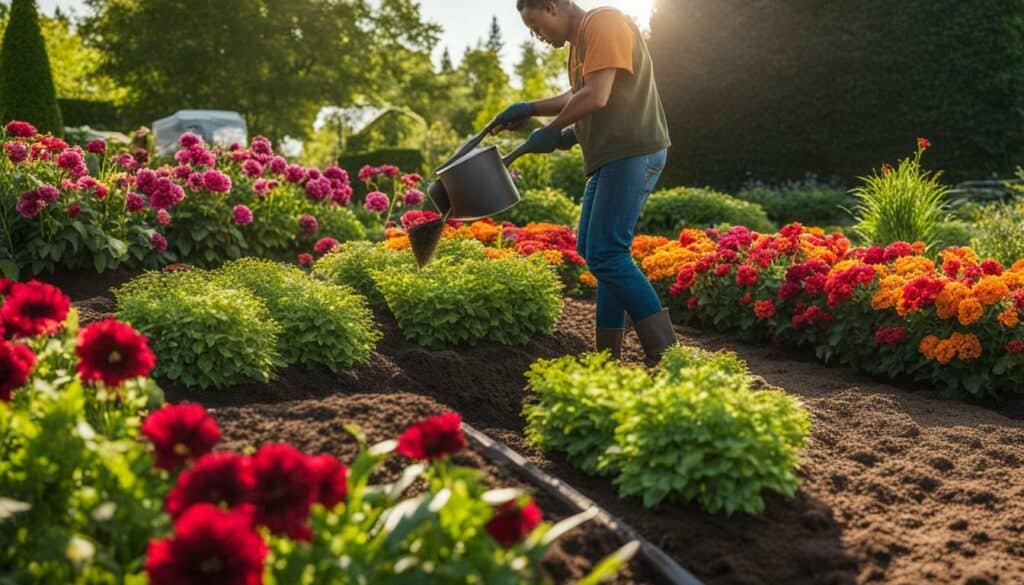
Seasonal Clean-Up: Maintaining the Long-Term Health and Vitality of Your Flower Bed
Seasonal clean-up is essential for maintaining the long-term health and vitality of your flower bed. As the seasons change, your garden requires proper care to ensure its continued beauty and growth. To assist you in this crucial task, I have compiled a list of essential tips and techniques that will help you keep your flower bed in prime condition throughout the year. Follow these guidelines, and your garden will thrive and bring you joy season after season.
1. Protect Tender Plants: In cold-winter climates, it’s crucial to provide a protective layer of mulch around tender plants. This will shield them from harsh temperatures and prevent frost damage, ensuring their survival through the winter months.
2. Cut Back Perennials: After the tops of your perennials have died back, it’s time to prune and cut them back. This helps promote healthy growth and prevents diseases from spreading. Be sure to remove any dead or diseased foliage to maintain a clean and tidy appearance.
3. Pinch Back Asters and Chrysanthemums: To keep asters and chrysanthemums more compact and bushy, pinch back their stems. This encourages new growth and enhances their overall appearance. Pinching back is especially important in late spring or early summer, before their buds start to develop.
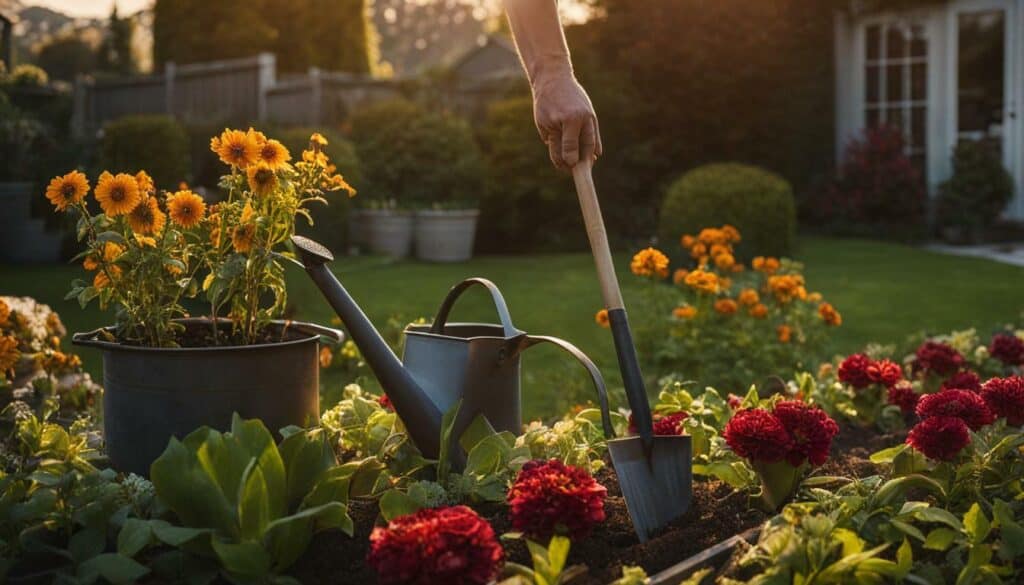
By incorporating these seasonal clean-up practices into your gardening routine, you’ll promote the long-term health and vitality of your flower bed. Remember to adapt these tasks to your specific climate and garden needs. With proper care, your flower bed will remain a stunning display of colors and blooms year after year.
Designing a Vibrant Flower Bed
Designing a flower bed that showcases vibrant colors and continuous blooms requires careful planning and consideration. By incorporating a variety of perennials and annuals, you can create a visually stunning garden that will brighten your outdoor space. Here are some tips to help you design a vibrant flower bed:
- Choose a focal point: Select a standout plant or feature as the focal point of your flower bed. This could be a tall and colorful perennial or a decorative element like a birdbath or sculpture.
- Consider plant spacing and heights: Arrange your plants in a way that allows each one to have enough space to grow and flourish. Pay attention to the height of each plant to create a visually appealing display with varying levels.
- Combine different flower shapes and colors: Mix flowers with different shapes, sizes, and colors to create a visually dynamic and interesting flower bed. Consider the color wheel and complementary colors to create bold and eye-catching combinations.
- Include seasonal interest: Incorporate plants that bloom at different times of the year to maintain interest and color throughout the seasons. This could include early spring bulbs, summer perennials, and fall-blooming flowers.
- Add texture and foliage: Don’t forget to include plants with interesting textures and foliage in your flower bed. This will add depth and visual interest to your garden, even when flowers are not in bloom.
Remember to regularly maintain your flower bed by removing spent flowers, fertilizing, mulching, and addressing any pest or weed issues. With proper care and attention, your flower bed will thrive and provide you with a beautiful and vibrant garden year after year.

In addition to selecting beautiful flowers and plants for your flower bed, maintaining well-defined edges is crucial to achieving a polished and professional-looking garden. Here are some tips for keeping your flower bed edges neat and tidy:
- Use a half-moon edger or garden spade: These tools will help you create clean and sharp edges for your flower bed. Use them to define the borders and keep the grass or other ground cover from encroaching.
- Regularly trim and shape: Trim the grass or ground cover along the edges of your flower bed on a regular basis to maintain clean lines. This will prevent the bed from looking unkempt and untidy.
- Apply a barrier: Consider installing a physical or invisible barrier, such as metal or plastic edging, to create a clean separation between your flower bed and the surrounding areas. This will help keep grass and weeds from creeping into the bed.
By maintaining well-defined edges, you enhance the overall aesthetic appeal of your flower bed, allowing it to stand out and create a beautiful focal point in your garden.
Considering Sunlight, Size, and Soil
Successful flower bed maintenance involves considering factors such as sunlight, garden size, and soil conditions. These elements play a crucial role in determining the health and overall success of your garden. By understanding and optimizing these factors, you can create an environment that allows your flowers to thrive.
Firstly, sunlight exposure is vital for flower growth. Different plants have varying light requirements, so it’s crucial to select flowers that are suited to the amount of sunlight your garden receives. Some varieties thrive in full sun, while others prefer partial shade. Take note of the sun’s movement throughout the day and observe which areas of your garden receive direct sunlight and which are shaded. This information will guide you in choosing the right flowers for each area.
Garden size also plays a role in flower bed maintenance. The size of your garden will determine the number and arrangement of flowers you can plant. Consider the available space and whether you want a dense, compact garden or a more spacious and airy landscape. Proper spacing between plants is essential to prevent overcrowding, facilitate airflow, and allow each flower to receive adequate sunlight and nutrients.
Next, soil conditions are crucial for the health of your flower bed. Conduct a soil test to determine its pH level and nutrient content. Most flowers thrive in slightly acidic to neutral soil. If your soil is too acidic or alkaline, you can amend it with organic matter or specific soil amendments to achieve the optimal pH level. Additionally, ensure that the soil has good drainage to prevent waterlogging, which can lead to root rot and other plant diseases.
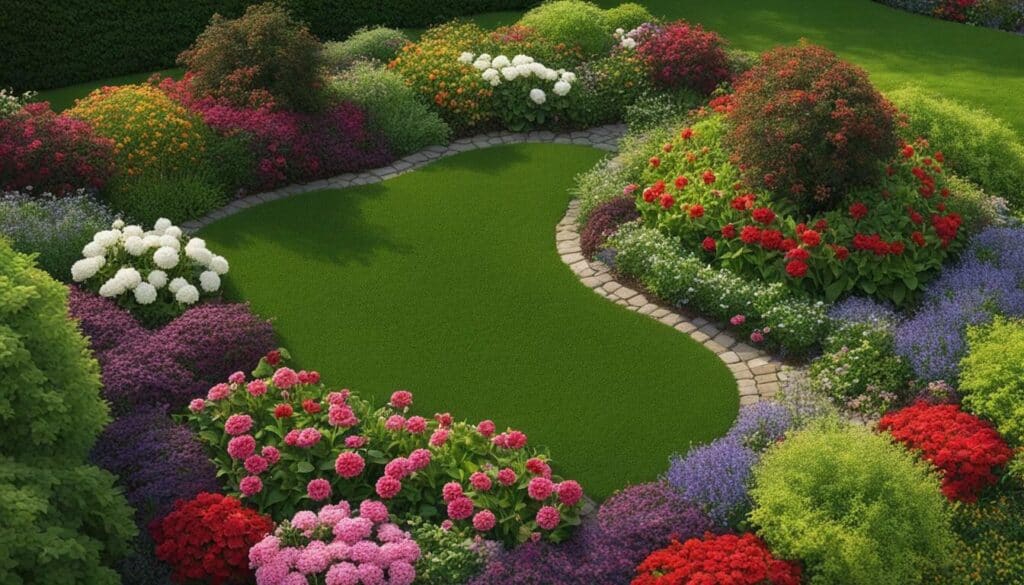
By carefully considering these factors, you can create a flower bed that is well-suited to your garden’s unique conditions. Whether you have a small urban garden or a sprawling backyard, understanding the importance of sunlight, garden size, and soil conditions will help you make informed decisions and achieve a vibrant and thriving flower bed.
Creating a Thriving Flower Bed
By following the right techniques and taking regular care of your flower bed, you can create a garden oasis filled with vibrant blooms that will bring you joy throughout the seasons. Mastering flower bed maintenance is essential for creating a blossoming garden. Perennial gardens require regular care to stay healthy and beautiful. Here are some tips for maintaining a perennial flower bed:
- Remove spent flowers: Snip off flower stems just above a leaf or bud to prevent the formation of seeds and pick off damaged leaves.
- Inspect for pests and problems: Look for leaves with holes, discolored or spotted leaves, chewed flowers or buds, or damaged stems. Seek advice from experienced staff at a garden center or cooperative extension service for identification and advice.
- Water: Ensure the soil is moist to a depth of 6-8 inches by watering. Soaker hoses and drip irrigation pipes are more efficient than overhead sprinklers.
- Pull weeds: Remove weeds as you see them, either by slicing them under the soil surface with a hoe or pulling them by hand.
- Edge the beds: Keep the edges of your garden and lawn well defined and tidy with a half-moon edger or garden spade.
- Fertilize and mulch: Apply a granular, slow-release fertilizer formulated for perennial gardens in early spring. Renew organic mulch, such as shredded bark or leaves.
- Seasonal clean-up: Protect tender plants in cold-winter climates with a layer of mulch. Cut back perennials after the tops die back. Pinch back asters and chrysanthemums to keep them more compact.
By following these steps and considering sunlight exposure, garden size, and soil preparation, you can create a stunning flower bed that will thrive and blossom year after year. Combine both perennial and annual flowers for a garden full of vibrant color and continuous blooms. Remember to design your flower bed with careful consideration of plant spacing and heights. With proper maintenance, your garden will flourish and bring joy throughout the seasons.
FAQ on Flower Bed Maintenance
Q: Why is flower bed maintenance important?
A: Flower bed maintenance is important for the overall health and beauty of your garden. Regular care ensures that your plants stay healthy, promotes continuous blooming, and helps prevent pests and diseases.
Q: How do I remove spent flowers?
A: To remove spent flowers, snip off the flower stem just above a leaf or bud. This prevents the formation of seeds and encourages new blooms to form.
Q: How can I identify pests and problems in my flower bed?
A: Look for leaves with holes, discolored or spotted leaves, chewed flowers or buds, or damaged stems. If you’re unsure about any issues, seek advice from experienced staff at a garden center or cooperative extension service.
Q: What is the best way to water a flower bed?
A: Ensure the soil is moist to a depth of 6-8 inches by watering. Soaker hoses and drip irrigation pipes are more efficient than overhead sprinklers.
Q: How do I control weeds in my flower bed?
A: Remove weeds as you see them, either by slicing them under the soil surface with a hoe or pulling them by hand. Regularly staying on top of weed control will help keep your flower bed healthy and vibrant.
Q: How do I maintain well-defined edges in my flower bed?
A: Keep the edges of your garden and lawn well defined and tidy with a half-moon edger or garden spade. This creates a clean and polished look for your flower bed.
Q: How should I fertilize and mulch my flower bed?
A: Apply a granular, slow-release fertilizer formulated for perennial gardens in early spring. Renew organic mulch, such as shredded bark or leaves, to help retain moisture and suppress weed growth.
Q: What should I do for seasonal clean-up in my flower bed?
A: Protect tender plants in cold-winter climates with a layer of mulch. Cut back perennials after the tops die back. Pinch back asters and chrysanthemums to keep them more compact.
Q: How can I design a vibrant flower bed?
A: Combine both perennial and annual flowers for a garden full of vibrant color and continuous blooms. Consider plant spacing and heights when designing your flower bed for a visually appealing arrangement.
Q: What factors should I consider when planning and maintaining my flower bed?
A: Consider sunlight exposure, garden size, and soil preparation when planning and maintaining your flower bed. These factors will help ensure your plants thrive and flourish.
Q: Why is proper flower bed maintenance essential for a thriving garden?
A: Proper flower bed maintenance promotes healthy plant growth, prevents pests and diseases, and creates a visually stunning garden. By following these tips and techniques, your flower bed will bring joy and beauty throughout the seasons.

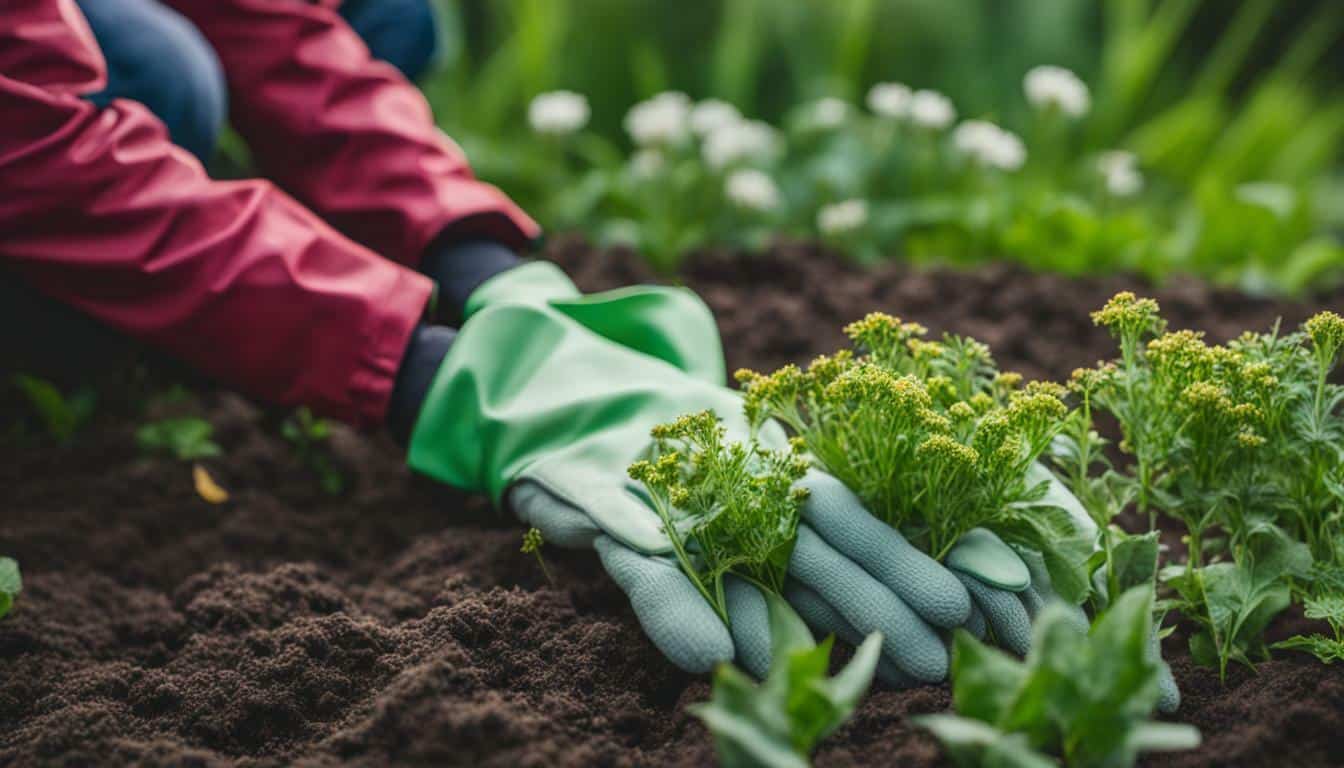



Leave a Reply